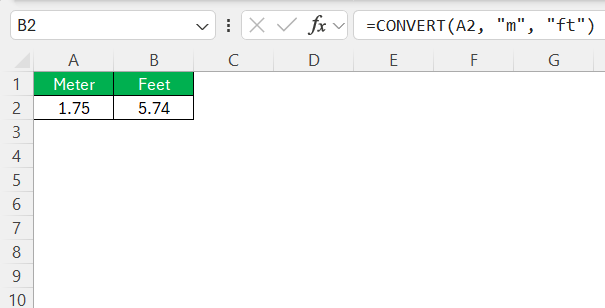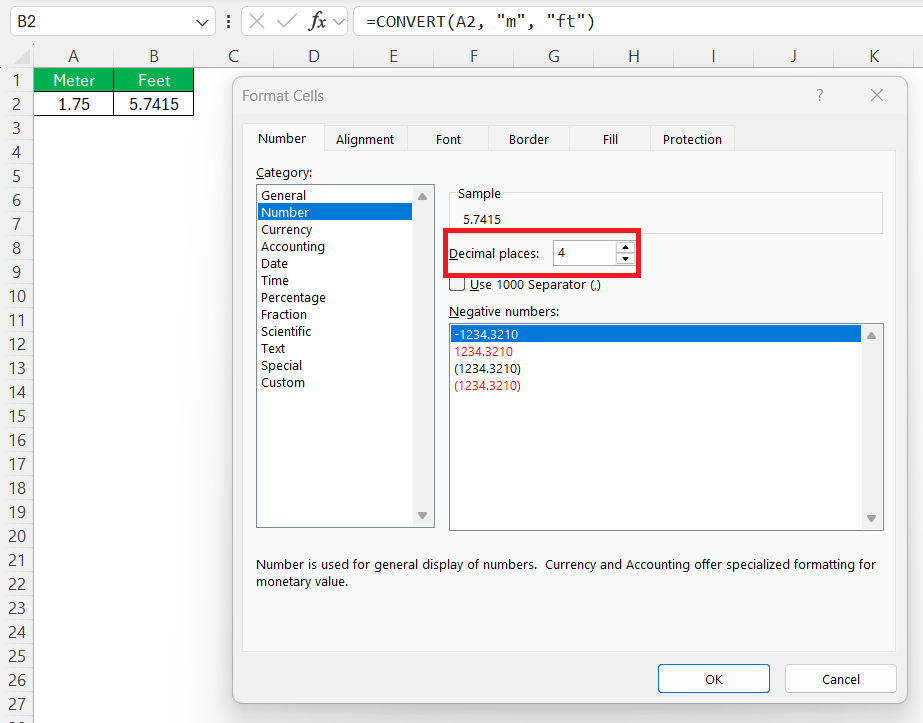Converting measurements from meters to feet is a common task that can be simplified using Excel. Whether you’re a student, engineer, or anyone who frequently deals with data manipulation, understanding this conversion can save time and enhance accuracy. Excel’s powerful functions offer an efficient way to perform such conversions with minimal effort, allowing for precise results every time. In this article, we will guide you on how to convert 1.75m to feet in Excel.
Key Takeaways:
- We can quickly convert 1.75 meters to feet using simple Excel formulas.
- Use =A2*3.28084 for manual conversion. This formula multiplies the meter value in A2 by 3.28084 to get feet.
- The CONVERT() function offers a cleaner, built-in method with unit recognition.
- Ignoring decimal places can lead to rounding errors—format cells to show full results.
- Always double-check that all data uses the same base unit before converting.
Table of Contents
Why convert 1.75m to Feet?
Practical Applications
Converting 1.75 meters to feet has several practical applications. In fields like construction, real estate, and interior design, measurements often need to be presented in both metric and imperial units to cater to different audiences. This conversion is also essential for travelers and international businesses, ensuring clear communication and understanding across various regions.
Excel serves as a handy tool, making it easy to toggle between units and maintain unit consistency in various reports and documents.
Understanding Measurement Units
Measurement units, such as meters and feet, are essential in quantifying length or distance. The metric system, which uses meters, is widely employed worldwide, offering a simpler base-10 structure. Conversely, the imperial system, which includes feet, is predominantly used in the United States.
By understanding these units, we can ensure accurate data translation and contextual understanding. Converting between these systems requires a specific conversion factor, where 1 meter equals approximately 3.28084 feet. Excel’s ability to handle these conversions efficiently makes it a preferred choice for many professionals.
Step-by-Step Conversion Process
Using Excel for Quick Conversion
Excel is an excellent tool for quickly converting meters to feet due to its straightforward formulas and ease of use. By entering a simple formula, you can instantly convert 1.75 meters to feet.
Let’s break down the formula used for converting meters to feet in Excel. The primary formula is =A2*3.28084, where A2 represents the cell containing the meter value you wish to convert. Here’s how it works:
- Cell Reference (
A2): This is the initial cell where you’ve input your value, e.g., 1.75 meters. - Multiplication Operator (
*): This operator multiplies your cell reference value by the conversion factor. - Conversion Factor (
3.28084): Since 1 meter equals approximately 3.28084 feet, this factor transforms the meter value into feet accurately.
Utilizing this formula ensures precise conversions every time, making Excel an efficient tool for such tasks. Here’s how you can do it: input “1.75” into a cell, then use the formula =A2*3.28084 (assuming “A2” is the cell with “1.75”).
This formula multiplies the meter value by the conversion factor, giving you the equivalent in feet. This method is quick, efficient, and reduces the risk of calculation errors, making it ideal for anyone who needs to perform frequent conversions.
Utilizing Built-In Functions
Excel comes with built-in functions that can further simplify the process of converting meters to feet. The CONVERT function is particularly useful for this purpose. Here’s how you can leverage it:
The CONVERT function follows the syntax =CONVERT(number, "from_unit", "to_unit"). For our conversion, you would input =CONVERT(A2, "m", "ft"), assuming the cell A2 contains the meter value.
This method is less error-prone since it uses predefined unit abbreviations. It eliminates the need to recall or manually enter conversion factors.
Using built-in functions streamlines the conversion process, ensuring consistency and minimizing potential errors.
Tips for Accuracy and Efficiency
To ensure both accuracy and efficiency when using Excel to convert meters to feet, consider these tips:
- Use Cell References: Always input your meter values into cells and reference them in your formulas, which reduces the potential for errors compared to hardcoding numbers directly within formulas.
- Create Templates: Design a template that includes the conversion formula, allowing you to quickly input new data without setting up the formula each time.
- Double-Check Unit Conversion Factor: Verify the conversion factor (3.28084) to prevent discrepancies, especially when handling large datasets.
- Leverage Named Ranges: Assign a name to cells containing frequently used values, improving readability and ease of formula adjustments.
By following these tips, you can enhance the reliability of your conversions while saving time and effort.
Common Mistakes and How to Avoid Them
Misunderstanding Decimal Conversions
Misunderstanding decimal conversions is a common pitfall when converting measurements in Excel. It’s crucial to comprehend how decimal and fractional values translate between systems. An issue often arises when users expect a simple one-to-one conversion without considering decimal precision. For example, converting 1.75 meters to feet yields approximately 5.74147 feet, but overlooking the decimal portion can lead to rounding discrepancies and inaccurate results.
To mitigate this, ensure that your Excel settings allow for sufficient decimal places in your results. Adjust the formatting to display the full numerical value and be wary of any predefined rounding rules that might skew the accuracy of your data.
By maintaining an awareness of potential decimal missteps, you can safeguard the precision of your conversions.
Omitting Unit Consistency Checks
Omitting unit consistency checks is a frequent mistake when performing conversions in Excel. Ensuring that all measurements are properly converted to the desired unit is critical for maintaining data accuracy. For instance, if you’re consistently working with meters, all input data should match this unit before conversion. Incorrect input, such as mixing feet and meters without adjustment, can result in significant errors.
To prevent this, establish a consistent unit system in your Excel sheets. Use data validation tools to restrict entry to specific units only or employ warning messages for unit mismatches.
Additionally, clearly labeling cell headers with the respective units can serve as a reminder to maintain uniformity. Consistently applying these checks ensures reliable outcomes and reduces the risk of inaccuracies in your work.
FAQs
What is the formula to convert meters to feet in Excel?
To convert meters to feet in Excel, use the formula =A1*3.28084, where “A1” is the cell with the meter value. Alternatively, use the CONVERT function: =CONVERT(A1, "m", "ft") for easier handling. Both methods provide accurate conversions, allowing for efficient unit translation directly within your spreadsheet.
Can I convert 1.75m directly to inches using Excel?
Yes, you can convert 1.75 meters directly to inches in Excel using the CONVERT function. Input the formula =CONVERT(A1, "m", "in"), with A1 being the cell containing 1.75. This will provide an accurate result in inches, streamlining the process without needing intermediate conversions.
Why is it important to show decimals when converting units in Excel?
When converting 1.75 meters, the accurate value is approximately 5.74147 feet. If Excel is set to show only 1 or 2 decimal places, you’ll lose vital precision. This rounding can be problematic in fields like engineering or architecture, where even small differences matter. Always format your result cells to display enough decimal points for the task.
What errors should I watch out for while converting measurements?
Common issues include mixing units (e.g., entering feet instead of meters) and rounding values too early. Another trap is hardcoding the conversion factor into every cell, which makes updates difficult. Use references and templates to maintain accuracy. Also, double-check your data entry for consistent unit use throughout the sheet.
Can I create a reusable template for meter-to-feet conversion in Excel?
Absolutely. Create a table with labeled columns for “Meters” and “Feet,” then apply either a custom formula or the CONVERT() function. Save the file as a template so you can enter new values anytime without setting up the formula again. You can even add dropdowns or conditional formatting for extra usability. Templates are a great way to scale your workflow efficiently.
John Michaloudis is a former accountant and finance analyst at General Electric, a Microsoft MVP since 2020, an Amazon #1 bestselling author of 4 Microsoft Excel books and teacher of Microsoft Excel & Office over at his flagship MyExcelOnline Academy Online Course.












